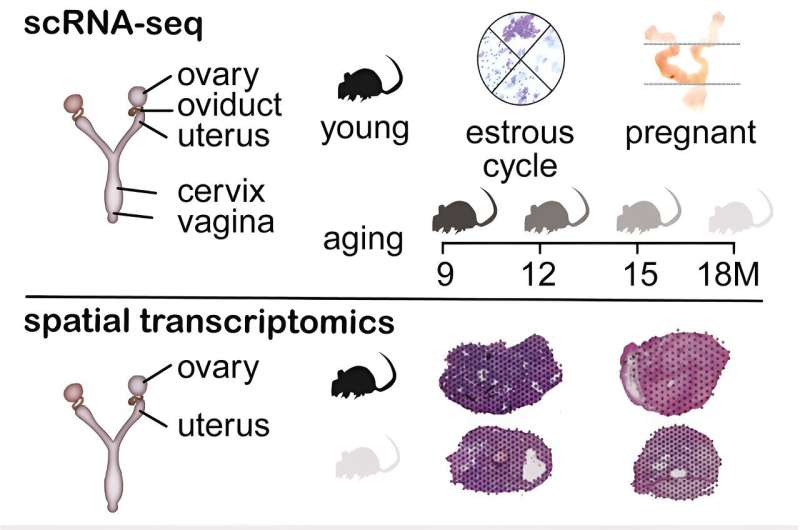This article has been reviewed according to Science X's editorial process and policies. Editors have highlighted the following attributes while ensuring the content's credibility:
fact-checked
peer-reviewed publication
trusted source
proofread
Exploring the unexpected long-term consequences of female fertility

The constant remodeling of the organs of the female reproductive tract during the reproductive cycle leads to fibrosis and chronic inflammation over the years. Scientists from the German Cancer Research Center (DKFZ) have now uncovered these unexpected long-term consequences of female reproductive function in mice. The results have been published in Cell.
The organs of the female reproductive tract undergo extensive remodeling during each menstrual cycle in preparation for ovulation or pregnancy. This process is similar in other female mammals, where it is called the estrous cycle.
Little research has been done into the recurring remodeling and its effects on the affected organs—the ovary, oviducts, uterus, cervix, and vagina. Many studies to date have been based purely on microscopic examinations or have only focused on individual organs or the activity of certain genes.
A team led by Ângela Gonçalves and Duncan Odom, both DKFZ, has now systematically investigated the changes in gene activity and morphology in each phase of the estrous cycle in all affected organs in mice—at the level of individual cells and at spatial resolution. The researchers were thus able to compile a cell atlas of the female reproductive tract.
The results show that connective tissue cells, fibroblasts, play a central and very organ-specific role in the remodeling of the reproductive tract by controlling the reorganization of the extracellular matrix and inflammation.
Many physiological reproductive events, such as ovulation, menstruation, or implantation of the fertilized egg, show characteristic signs of inflammation. The molecular signaling pathways and molecules responsible for maintaining this inflammation originate largely from fibroblasts, one of the main sources of pro-inflammatory messengers.
A remarkable feature of the female reproductive tract is its ability to rapidly clear these cyclic inflammations and restore normal reproductive function. Inflammation that does not subside, in conjunction with other signs of aging, can become chronic and lead to fibrosis.
Based on their findings, the DKFZ researchers developed a model in which the repeated remodeling of the reproductive tract over the reproductive lifespan drives a gradual, age-related development of fibrosis and chronic inflammation. They were able to test this hypothesis directly by switching off the estrous cycle with drugs. This cycle blockade reduced the progression of fibrosis, while other aging processes continued to occur normally.
"In humans, a higher lifetime number of menstrual cycles is associated with a higher risk of uterine cancer. If chronic inflammation and fibrosis also accumulate with the number of cycles in women, this could be a contributing factor to the increased risk of cancer," explains Duncan Odom.
Ângela Gonçalves adds, "Our atlas sheds light on how estrous, pregnancy, and aging together shape the female reproductive tract. For a long time, it was thought that these events leave no traces or scars in the affected organs. Our work reveals the unexpected costs to the female reproductive capacity caused by the constant remodeling of the reproductive tract."
More information: Ivana Winkler et al, The cycling and aging mouse female reproductive tract at single-cell resolution, Cell (2024). DOI: 10.1016/j.cell.2024.01.021




















